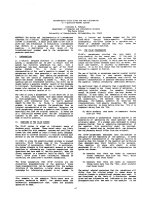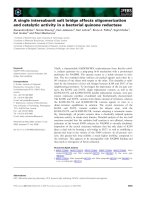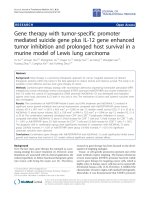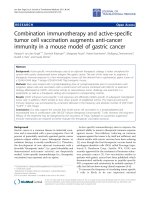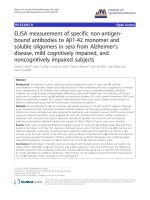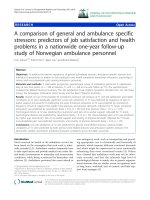Single marker analysis using Transposon specific markers (AhMITE1) for yield, foliar disease resistance and oil quality in a mutant population of groundnut (Arachis hypogaea L.)
Bạn đang xem bản rút gọn của tài liệu. Xem và tải ngay bản đầy đủ của tài liệu tại đây (238.53 KB, 10 trang )
Int.J.Curr.Microbiol.App.Sci (2019) 8(3): 2376-2385
International Journal of Current Microbiology and Applied Sciences
ISSN: 2319-7706 Volume 8 Number 03 (2019)
Journal homepage:
Original Research Article
/>
Single Marker Analysis Using Transposon Specific Markers (AhMITE1)
for Yield, Foliar Disease Resistance and Oil Quality in a Mutant
Population of Groundnut (Arachis hypogaea L.)
Venkatesh1, A.G. Vijaykumar1, B.N. Motagi1 and R.S. Bhat2*
1
Department of Genetics and Plant Breeding, 2Department of Biotechnology,
University of Agricultural Sciences, Dharwad, 580 005, Karnataka, India
*Corresponding author
ABSTRACT
Keywords
Groundnut, Yield,
Disease resistance,
Oil quality,
AhMITE1markers
Article Info
Accepted:
20 February 2019
Available Online:
10 March 2019
A population of 53 mutants, their parents and eight cultivated varieties belonging to two
subspecies of groundnut were evaluated during kharif 2012 for productivity, oil quality
traits and resistance to late leaf spot (LLS) and rust diseases to assess association between
these traits and the Arachis hypgaea Miniature Inverted-Repeat Transposable Elements
(AhMITE1) markers. Genotypes showed significant differences and high PCV and GCV
for all the traits. Of the 41 transposable elements (TE) markers used for genotyping the
population, 24 showed high to moderate genotype discriminating power in terms of
polymorphism information content (PIC). Single marker analysis revealed significant
association of AhTE205 with number of pods per plant, pod yield per plant and shelling
percentage. While the other markers that should significant association are AhTE333 with
test weight, AhTE343 with LLS (90 DAS), AhTE373 with oil content (%) and AhTE211
with oleate content and O:L ratio. These markers need to be validated for their trait
association before they are employed for groundnut improvement.
Introduction
Cultivated groundnut (Arachis hypogaea L.)
is a tetraploid with an AB-genome
(2n=4x=40) of recent origin, arising from
hybridization of two wild species followed by
spontaneous
chromosome
duplication.
Subsequent formation of two subspecies (ssp.
hypogaea and ssp. fastigiata) and several
botanical varieties of domesticated groundnut
(Krapovickas and Gregory, 1994) probably
took place when the primitive form of
groundnut was used for cultivation where it
was subjected to artificial selection pressures
(Kochert et al., 1996).
In addition to the artificial selection, several
evidences have been presented in support of
“Mutational theory” of evolution of
groundnut. The possible role of spontaneous
and induced mutations in the evolution of
abundant
morphological
variation
in
groundnut was also evident from various
subspecific changes brought about by
2376
Int.J.Curr.Microbiol.App.Sci (2019) 8(3): 2376-2385
mutations in a few breeding programmes
(Mouli et al., 1979; Prasad, 1989; Gowda et
al., 1996).
Dharwad Early Runner (DER) a true breeding
variant identified from a cross between two
fastigiata cultivars viz., Dh 3-20 and CGC-1,
sharing the characters of both the subspecies
of A. hypogaea upon mutagenesis with ethyl
methane sulphonate (EMS) yielded a high
frequency of mutants resembling all the four
botanical varieties (Gowda et al., 1996).
Some of the mutants produced germinal
reversions to DER in later generations,
indicating genetic instability. In many cases,
the breeding behaviour of mutants revealed
several unusual features (such as homozygous
mutations, mutation outbursts, segregation
distortions, somatic mutations and multiple
character mutations) that could not be
explained through conventional mutation
theory, indicating the activation of cryptic
transposable elements (TEs) as the possible
cause of mutations (Gowda et al., 1996).
Further investigations on such mutants
showed the activity of miniature inverted
repeat transposable element (MITEs) in the
mutational and evolutionary origin of
botanical types of groundnut (Bhat et al.,
2008; Gowda et al., 2010; Gowda et al.,
2011). MITEs are the non-autonomous class
II type transposable elements (Osborne et al.,
2006) that make up the predominant TEs
among plant genomes (Wessler et al., 1995;
Shan et al., 2005; Naito et al., 2006).
Transposition preference for low copy genic
regions signifies the role of MITEs in
modulating gene expression (Wessler, 1998;
Zhang et al., 2000; Wessler, 2001; Lu et al.,
2012) and aiding crop evolution (Ma and
Bennetzen, 2004; Shan et al., 2005; Naito et
al., 2006).
Since the distribution pattern of MITE
insertion varies across individuals and
germplasm, TE-specific markers were
developed (Bonin et al., 2008; Grzebelus et
al., 2009; Monden et al., 2009) and the
distribution pattern and frequency of excision
of a MITE were determined. A total of 504
PCR based markers were developed using
primer pairs designed against both flanking
sequences of each MITE element. These
markers
showed
considerably
high
polymorphism (22.0%) (Shirasawa et al.,
2011)
than
that
of
the
SSR
markers (Koilkonda et al., 2012; Pandey et
al., 2012). Later through in silico analysis,
another 535 transposon markers were
developed and validated (Shirasawa et al.,
2012b). Transposon markers, like SSR
markers, represent potent, co-dominant, and
PCR-based markers. They basically detect the
transposition of AhMITE1 at various sites,
preferably in the genic region in the genome.
A large population of independent mutants
which differ for productivity, foliar disease
resistance and quality traits was developed
and characterized at UAS, Dharwad (Gowda
et al., 1989; Gowda and Nadaf, 1992; Gowda
et al., 1996). A detailed phenotypic and
genotypic analysis with TE markers would
help in identifying the markers that are
significantly associated with productivity,
foliar disease resistance and quality traits.
Identification of marker(s) significantly
associated with any trait of economical and
agronomical importance is always useful in
crop improvement. Trait-marker mapping can
be done through linkage and/or association
mapping
(Pasupuleti
et
al.,
2013).
Identification of DNA markers strongly
associated with productivity, foliar disease
resistance and quality traits may prove useful
for groundnut improvement through marker
assisted selection. The present investigation
was undertaken to evaluate and characterize
mutants for associating productivity, disease
resistant and quality traits using transposon
specific (AhMITE1) markers.
2377
Int.J.Curr.Microbiol.App.Sci (2019) 8(3): 2376-2385
Materials and Methods
Field experiment
The study employed a mutant population of
53 mutants their parent DER and eight check
varieties. The field experiment was conducted
during kharif 2012 at IABT Garden of Main
Agricultural Research Station, UAS, Dharwad
belonging to transitional tract of Karnataka.
The experimental block consisted of vertisol
soil with pH of 7.0-7.5. The mutants and
parents of the mutant population were sown
with two rows of 2.50 m in a Randomized
Complete Block Design (RCBD) with a
spacing of 45 cm between rows and 10 cm
between plants in two replications. Standard
package of practice was followed to raise the
crop. Mutants and their parents were
evaluated for growth, morphological,
productivity and nutritional traits, and
response to late leaf spot and rust disease.
Most of the field observations were recorded
on five randomly selected plants as per the
groundnut descriptor (IBPGR\ICRISAT,
1992) and the mean value was computed for
each genotype.
Genotyping of mutants with markers
transposon specific (AhMITE1) markers
2012a; Shirasawa et al., 2012b). DNA
amplification was performed in a 20 l
reaction mixture with appropriate PCR profile
using Eppendorf Mastercycler® pro and
BIO-RAD T100TM Thermal cyclers. Touchdown PCR was carried out in a final volume
of 20 ll containing 50 ng genomic DNA, 10X
PCR buffer, 2 mM dNTPs, 10 pmol of each
primer and 1 U of Taq DNA Polymerase
(New England Biolabs, Ipswich, MA, USA)
for the rust and LLS resistance-linked
markers. Amplification was carried out in a
mastercycler
(Eppendorf,
Hamburg,
Germany) by setting the conditions for one
cycle of pre-denaturation (94°C for 5 min), 38
cycles of denaturation (94 °C for 2 min),
annealing (starting from 52 °C for 1 min with
a decrease of 1 °C/cycle for the first five
cycles) and extension (72 °C for 2 min). One
cycle of final elongation (72 °C for 10 min)
was included before the product was held at 4
°C for 30 min. The PCR products were mixed
with 2 μl of loading dye (Bromophenol blue)
and loaded on 1.5% agarose gel prepared in
1X TAE buffer containing ethidium bromide
(5 l/100 ml). Products were separated at 80
volts till they clearly resolved. The gel was
observed and documented with DNA BioImaging system.
Scoring the alleles
DNA was isolated from the young leaves of
mutants and parents and check varieties
grown in the field by following the modified
Cetyl Trimethyl Ammonium Bromide
(CTAB) method (Cuc et al., 2008). DNA
yield was quantified by using Nano Drop (UV
technologies, USA). DNA concentration and
purity was also checked by running the
samples on 0.8% agarose gel with known
concentration of uncut lambda DNA of 50
ng/l, 100 ng/l and 200 ng/l. The DNA
stocks of the samples were diluted to a
working concentration of 5 ng/l. Mutants
and parents were genotyped with transposon
marker (AhTE markers) (Shirasawa et al.,
Specific PCR product was identified for each
marker (Shirasawa et al., 2012a; Shirasawa et
al., 2012b) and scored as “2” (with AhMITE1
insertion), “1” (without AhMITE1 insertion)
or “0” (absence of specific PCR product).
Statistical analysis
Statistical analysis for the phenotypic data
was carried out using statistical package
Windostat Version 8.1 available at
Department of Genetics and Plant Breeding,
University
of
Agricultural
Sciences,
Dharwad. Analysis of variance (ANOVA) for
2378
Int.J.Curr.Microbiol.App.Sci (2019) 8(3): 2376-2385
different characters was computed by using
the mean phenotypic data on each genotype in
order to partition the variation due to different
sources following the method given by Panse
and Sukhatm (1954). Molecular marker data
was analyzed for polymorphic information
content (PIC), and the association of the
markers with productivity, disease resistance
and quality traits was tested by Single marker
analysis (SMA) using WinQTL Cartographer
version 2.5 (Wang et al., 2007).
Polymorphism information content (PIC)
analysis
Results and Discussion
Markers were classified as high (≥ 0.5),
medium (0.26 to 0.49) and low (≤0.25) based
on the PIC value. In total, 7, 17 and 17
markers were identified as high, medium and
low for their genotype-discriminating power,
respectively. Twenty four (58%) out of 41
AhTE markers used for molecular assay
reported moderate to high PIC value, this
indicates that most of the AhMITE1 specific
markers
posses
better
genotypediscriminating power over commonly used
SSR markers in groundnut (Shirasawa et al.,
2012a; Koilkonda et al., 2012; Pandey et al.,
2012).
Analysis of variance for the mutant
population consisting of a mutant population
consisting of 53 mutants their parent DER and
eight check varieties showed significant
genotypic differences for all the productivity
and quality traits studied. Genotypes also
differed significantly for rust and LLS
resistance except for LLS at 70 DAS.
Phenotypic coefficient of variation (PCV) and
genotypic coefficient of variation (GCV)
revealed high variability for number of
pods/plant and pod yield/plant, and moderate
variability for other traits (Table 1). LLS and
rust resistance at three stages exhibited
moderate variability (Table 2). Similarly,
nutritional traits showed moderate or low
variability (Table 3). Number of pods/plant
and pod yield/plant also showed very high
heritability and genetic advance over mean,
indicating the scope for selection among the
genotypes. SMK, test weight and pod length
showed high heritability though they had
moderate level of variability (Table 1).
Moderately high heritability was observed for
LLS and rust resistance at 80 and 90 DAS
compared to 70 DAS (Table 2). In general, all
nutritional traits recorded very high
heritability with moderate GAM. However,
O/L recorded highest genetic advance over
mean (56.01%), indicating the scope for
selecting superior genotypes for this trait
(Table 3).
Power of each marker to discriminate the
genotypes was calculated by estimating
polymorphism information content (PIC)
value. PIC values ranged from 0 (AhTE347,
AhTE442,
AhTE445,
AhTE376
and
AhTE300) to 0.50 (AhTE121, AhTE489,
AhTE426, AhTE205, AhTE113 AhTE148
and AhTE319).
Single marker analysis (SMA)
The mutant population such as the one used in
this study allows analysing marker-trait
association. Single marker analysis was
performed using the phenotypic data on all 62
genotypes to determine the strength of
association between 41 AhTE markers and a
given trait by calculating F statistic and
simple linear regression coefficient (Haley
and
Knott,
1992)
using
WinQTL
Cartographer version 2.5 (Wang et al., 2007).
Statistically significant association of at least
one marker was observed with the traits
studied. AhTE205 had a significant
association and high R2 for number of pods
per plant, pod yield per plant and shelling
percentage.
2379
Int.J.Curr.Microbiol.App.Sci (2019) 8(3): 2376-2385
Table.1 Estimates of genetic parameters for agronomic traits among mutant population and check varieties of groundnut
Traits
Mean
Plant height (cm)
Primary branch length (cm)
No. of primary branches
No. of secondary branches
Leaf length (cm)
Leaf width (cm)
Shelling percentage (%)
Sound mature kernel (%)
Test weight (g)
Pod length (cm)
Pod width (cm)
No. of pods per plant
Pod yield per plant (g)
28.39
33.95
7.11
2.92
5.50
2.66
51.36
81.77
31.88
2.80
1.29
15.12
9.98
Range
Min
15.06
21.56
3.40
0.00
3.57
2.08
22.00
19.00
20.00
1.76
0.92
4.05
1.40
PCV
(%)
18.04
13.86
15.38
17.15
13.32
17.69
18.95
9.31
14.93
12.06
18.04
39.09
50.33
Max
42.30
64.57
14.20
26.40
7.74
4.41
72.00
96.50
53.50
3.99
2.43
37.95
30.63
GCV
(%)
13.11
4.46
13.43
14.62
8.44
15.27
16.36
9.15
14.26
11.90
13.11
37.95
49.18
h² (broad
sense) (%)
53
10
76
73
40
75
75
97
91
97
53
94
96
GA
GAM
0.25
0.10
1.42
1.83
0.40
1.57
2.02
1.96
0.81
11.63
0.25
11.48
9.88
19.61
2.96
24.17
25.68
11.01
27.15
29.09
18.52
28.07
24.17
19.61
75.89
99.02
Table.2 Estimates of genetic parameters for LLS and rust resistance traits among mutant population and check varieties of groundnut
Traits
Late leaf spot at 70 DAS
Late leaf spot at 80 DAS
Late leaf spot at 90 DAS
Rust at 70 DAS
Rust at 80 DAS
Rust at 90 DAS
Mean
3.52
5.88
7.10
3.60
5.78
6.95
Range
Min
Max
PCV
(%)
GCV
(%)
3.00
4.00
4.00
3.00
4.00
4.00
5.50
8.00
9.00
5.00
7.50
9.00
13.86
15.38
17.15
13.32
17.69
18.95
4.46
13.43
14.62
8.44
15.27
16.36
2380
h²
(broad
sense) (%)
10
76
73
40
75
75
GA
GAM
0.10
1.42
1.83
0.40
1.57
2.02
2.96
24.17
25.68
11.01
27.15
29.09
Int.J.Curr.Microbiol.App.Sci (2019) 8(3): 2376-2385
Table.3 Estimates of genetic parameters for nutritional quality traits among mutant population and check varieties of groundnut
Traits
Palmitic acid
Stearic acid
Oleic acid
Linoleic acid
Oleic: Lenoleic
acid
Arachidic acid
Eicosenoic acid
Behenic acid
Lignoseric acid
Protein content
(%)
Oil content (%)
Mean
Range
Min
Max
PCV
(%)
GCV
(%)
10.58
2.87
48.14
33.73
1.49
GA
GAM
9.15
14.26
11.90
14.95
27.58
h²
(Broad
sense) (%)
97
91
97
98
97
7.20
1.44
33.21
22.00
0.70
12.12
4.07
60.91
47.33
2.68
9.31
14.93
12.06
15.11
27.97
1.96
0.81
11.63
10.27
0.83
18.52
28.07
24.17
30.45
56.01
1.09
0.97
3.75
1.23
29.85
0.76
0.76
3.07
1.02
19.60
1.59
1.18
4.86
1.47
36.88
19.66
9.00
10.80
8.70
10.61
19.50
8.85
10.63
8.43
10.57
98
97
97
94
99
0.43
0.18
0.81
0.21
6.48
39.83
17.94
21.55
16.81
21.70
47.8
42.5
54.4
4.86
4.89
98
4.70
9.95
Table.4 Potential markers associated with important productivity, nutritional traits and disease resistance
Sl. No.
1
2
3
4
5
6
7
8
Marker
AhTE205
AhTE205
AhTE205
AhTE333
AhTE343
AhTE373
AhTE211
AhTE211
Trait
Pods per plant
Pod yield per plant
Shelling percentage
Test weight
LLS (90 DAS)
Oil content
Oleate
O:L ratio
2381
R2 (%)
21
14
29
23
14
20
19
15
Int.J.Curr.Microbiol.App.Sci (2019) 8(3): 2376-2385
Similarly, AhTE333 for test weight,
AhTE343 for LLS (90 DAS), AhTE373 for
oil content (%) and AhTE211 for oleate
content and O:L ratio had significant
association and high R2 (Table 4). AhTE205
showing significant association with most of
the productivity traits like number of pods per
plant, pod yield per plant and shelling
percentage is of significance in groundnut
breeding. However, the markers identified in
this study as associated with productivity,
disease resistance and quality traits need to be
validated across genotypes. Similar marker
trait association studies have been attempted
to identify markers linked to taxonomic,
agronomic, productivity, foliar disease
resistance and nutritional quality traits in
groundnut for their utilization in groundnut
improvement through marker assisted
selection (Anita et al., 2015; Hake et al.,
2017a; Hake et al., 2017b; Zongo et al.,
2017).If phenotypic variation explained
(PVE) by a marker is more than 10%, it is
considered to be a major marker and this
method has been used by several researchers
to signify the marker and trait association
(Collard et al., 2005; Zongo et al., 2017).
In conclusion out of 41 markers used for
marker trait association, five markers
(AhTE205, AhTE333, AhTE343, AhTE373
and AhTE211) reported more than 10% PVE
for different traits in the study, indicating
their importance in trait selection through
MAS. More importantly, since the transposon
specific (AhMITE1) markers used in this
study indicate the site of transposition, they
would prove useful in unraveling the gene(s)
involved in such transpositions leading to trait
variation.
References
Anitha,
B.
K.,
Manivannan,
N.,
Anandakumar, C.R. and Ganesamurthy,
K., 2015. Single Marker Analysis for
Oil Yield and Component Traits in
Groundnut
(Arachis
hypogaea
L.). Madras
Agricultural
Journal, 102(1-3), pp.6-9
Bhat, R. S., Patil, V. U., Chandrashekar, T.
M., Sujay, V., Gowda, M. V. C. and
Kuruvinashetti,
M.
S.,
2008,
Recovering flanking sequence tags of
miniature inverted-repeat transposable
element by thermal asymmetric
interlaced-PCR in groundnut. Curr. Sci.,
95 (4): 452-453.
Bonin, A., Paris, M., Després, L., Tetreau, G.,
David, J.-P. and Kilian, A., 2008, A
MITE-based genotyping method to
reveal
hundreds
of
DNA
polymorphisms in an animal genome
after a few generations of artificial
selection. BMC Genomics, 9 (1): 459.
Collard, B.C.Y., Jahufer, M.Z.Z., Brouwer,
J.B. and Pang, E.C.K., 2005. An
introduction to markers, quantitative
trait loci (QTL) mapping and markerassisted selection for crop improvement:
the basic concepts. Euphytica, 142(1-2),
pp.169-196.
Cuc, L. M., Mace, E. S., Crouch, J. H.,
Quang, V. D., Long, T. D. and
Varshney, R. K., 2008, Isolation and
characterization of novel microsatellite
markers and their application for
diversity assessment in cultivated
groundnut (Arachis hypogaea). BMC
Plant Biol., 8 (1): 55.
Gowda, M. and Nadaf, H. L., 1992, Induced
mutants of taxonomical importance in
groundnut (Arachis hypogaea L.). Intl.
Arachis Newslett, 12: 9-11.
Gowda, M., Nadaf, H. L and Giriraj, K.,
1989, A new growth habit variant of
taxonomical importance in groundnut
(Arachis hypogaea L.). Intl. Arachis
Newslet., 6 (6): 48-54.
Gowda, M. V. C., Nadaf, H. L. and
Sheshagiri, R., 1996, The role of
mutations in intraspecific differentiation
2382
Int.J.Curr.Microbiol.App.Sci (2019) 8(3): 2376-2385
of groundnut (Arachis hypogaea L.).
Euphytica, 90(1): 105-113.
Gowda, M. V. C., Bhat, R. S., Motagi, B. N.,
Sujay, V., Varshakumari and Bhat, S.,
2010, Association of high-frequency
origin of late leaf spot resistant mutants
with
AhMITE1
transposition
in
groundnut. Plant Breed., 129(5): 567569.
Gowda, M. V. C., Bhat, R. S., Sujay, V.,
Kusuma, P., Varshakumari, Bhat, S. and
Varshney, R. K., 2011, Characterization
of AhMITE1 transposition and its
association with the mutational and
evolutionary origin of botanical types in
groundnut (Arachis spp.). Plant Syst.
Evol., 291(3-4): 153-158.
Grzebelus, D., Gładysz, M., Macko-Podgórni,
A., Gambin, T., Golis, B., Rakoczy, R.
and Gambin, A., 2009, Population
dynamics of miniature inverted-repeat
transposable elements (MITEs) in
Medicago truncatula. Gene, 448(2):
214-220.
Hake, A.A., Shirasawa, K., Yadawad, A.,
Nayak, S.N., Mondal, S., Badigannavar,
A.M., Nadaf, H.L., Gowda, M.V.C. and
Bhat, R.S., 2017a. Identification of
transposable
element
markers
associated with yield and quality traits
from an association panel of
independent mutants in peanut (Arachis
hypogaea L.). Euphytica, 213(12): 283.
Hake, A.A., Shirasawa, K., Yadawad, A.,
Sukruth, M., Patil, M., Nayak, S.N.,
Lingaraju, S., Patil, P.V., Nadaf, H.L.,
Gowda, M.V.C. and Bhat, R.S., 2017b.
Mapping of important taxonomic and
productivity traits using genic and nongenic transposable element markers in
peanut (Arachis hypogaea L.). PloS
one, 12(10), p.e0186113.
Koilkonda, P., Sato, S., Tabata, S., Shirasawa,
K., Hirakawa, H., Sakai, H., Sasamoto,
S., Watanabe, A., Wada, T., Kishida,
Y., Tsuruoka, H., Fujishiro, T.,
Yamada, M., Kohara, M., Suzuki, S.,
Hasegawa, M., Kiyoshima, H. and
Isobe,
S.,
2012,
Large-scale
development of expressed sequence tagderived simple sequence repeat markers
and diversity analysis in Arachis spp.
Mol. Breed., 30 (1): 125-138.
Krapovickas, A. and Gregory, W. C., 1994,
Taxonomía
del
género
Arachis
(Leguminosae). Bonplandia, 8: 1-186.
Kochert, G., Stalker, H. T., Gimenes, M.,
Galgaro, L., Lopes, C. R. and Moore,
K., 1996, RFLP and cytogenetic
evidence on the origin and evolution of
allotetraploid domesticated groundnut,
Arachis hypogaea (Leguminosae). Am.
J. Bot., 83 (10): 1282-1291.
Lu, C., Chen, J., Zhang, Y., Hu, Q., Su, W.
and Kuang, H., 2012, Miniature
inverted–repeat transposable elements
(MITEs) have been accumulated
through amplification bursts and play
important roles in gene expression and
species diversity in Oryza sativa. Mol.
Biol. Evol., 29 (3): 1005-1017.
Ma, J. and Bennetzen, J. L., 2004, Rapid
recent growth and divergence of rice
nuclear genomes. Proc. Natl. Acad. Sci.
USA, 101(34): 12404-12410.
Monden, Y., Naito, K., Okumoto, Y., Saito,
H., Oki, N., Tsukiyama, T., Ideta, O.,
Nakazaki, T., Wessler, S. R. and
Tanisaka, T., 2009, High potential of a
transposon mPing as a marker system in
japonica × japonica cross in rice. DNA
Res., 16(2): 131-140.
Mouli, C., Kale, D. M. and Patil, S. H., 1979,
Sequential
flowering
large
pod
Trombay groundnut (Abst.). Paper
presented In: Symposium on the Role of
Induced
Mutations
in
Crop
Improvement, Hyderabad, India, p. 27.
Naito, K., Cho, E., Yang, G., Campbell, M.
A., Yano, K., Okumoto, Y., Tanisaka,
T. and Wessler, S. R., 2006, Dramatic
amplification of a rice transposable
2383
Int.J.Curr.Microbiol.App.Sci (2019) 8(3): 2376-2385
element during recent domestication.
Proc. Natl. Acad. Sci. USA, 103 (47):
17620-17625.
Osborne, P. W., Luke, G. N., Holland, P. W.
H. and Ferrier, D. E. K., 2006,
Identification and characterisation of
five novel Miniature Inverted-repeat
Transposable Elements (MITEs) in
amphioxus (Branchiostoma floridae).
Intl. J. Biol. Sci., 2(2): 54-60.
Pandey, M. K., Gautami, B., Jayakumar, T.,
Sriswathi, M., Upadhyaya, H. D.,
Gowda, M. V. C., Radhakrishnan, T.,
Bertioli, D. J., Knapp, S. J., Cook, D. R.
and Varshney, R. K., 2012, Highly
informative genic and genomic SSR
markers to facilitate molecular breeding
in cultivated groundnut (Arachis
hypogaea). Plant Breed., 131 (1): 139147.
Panse, V. G. and Sukhatme, P. V., 1954,
Statistical methods for agricultural
workers. ICAR, New Delhi.
Prasad, M. V. R., 1989, Genetic
differentiation in Arachis hypogaea L.
In: Recent Advances in Genetics and
Cytogenetics. Eds. Farook, S. A. and
Khan, I. A., Premier Publishing House,
Hyderabad, India., pp. 53-55.
Pasupuleti, J., Nigam, S. N., Pandey, M. K.,
Nagesh, P. and Varshney, R. K., 2013,
Groundnut improvement: use of genetic
and genomic tools. Frontiers in Plant
Sci., 4: 58-61.
Shan, X., Liu, Z., Dong, Z., Wang, Y., Chen,
Y., Lin, X., Long, L., Han, F., Dong, Y.
and Liu, B., 2005, Mobilization of the
active MITE transposons mPing and
Pong in rice by introgression from wild
rice (Zizania latifolia Griseb.). Mol.
Biol. Evol., 22(4): 976-990.
Shirasawa, K., Hirakawa, H., Hasegawa, M.,
Kiyoshima, H., Kuroda, S., Kuwata, C.,
Suzuki, S., Naito, Y., Kuboyama, T.,
Tabata, S. and Isobe, S., 2011, Genetic
mapping of cultivated groundnut with
genomic SSR and transposon markers
screened by in silico polymorphic
analysis. Paper presented In: 5th Intl.
Conf. of the Groundnut Res. Commun.
on Advances in Arachis through
Genomics and Biotechnology (AAGB2011), Brasilia, Brazil, 13-15 June
2011.
Shirasawa, K., Hirakawa, H., Tabata, S.,
Hasegawa, M., Kiyoshima, H., Suzuki,
S., Sasamoto, S., Watanabe, A.,
Fujishiro, T. and Isobe, S., 2012a,
Characterization of active miniature
inverted-repeat transposable elements in
the groundnut genome. Theor. Appl.
Genet., 124 (8): 1429-1438.
Shirasawa, K., Koilkonda, P., Aoki, K.,
Hirakawa, H., Tabata, S., Watanabe,
M., Hasegawa, M., Kiyoshima, H.,
Suzuki, S., Kuwata, C., Naito, Y.,
Kuboyama, T., Nakaya, A., Sasamoto,
S.,
Watanabe,
A.,
Kato,
M.,
Kawashima, K., Kishida, Y., Kohara,
M., Kurabayashi, A., Takahashi, C.,
Tsuruoka, H., Wada, T. and Isobe, S.,
2012b, In silico polymorphism analysis
for the development of simple sequence
repeat and transposon markers and
construction of linkage map in
cultivated groundnut. BMC Plant Biol.,
12 (1): 80.
Wang, S., Basten, C. and Zeng, Z., 2007,
Windows QTL cartographer 2.5. Thesis,
North Carolina State University,
Raleigh, NC, USA.
Wessler, S. R., 1998, Transposable elements
associated with normal plant genes.
Physiol. Plant., 103 (4): 581-586.
Wessler, S. R., 2001, Plant transposable
elements. A hard act to follow. Plant
Physiol., 125(1): 149-151.
Wessler, S. R., Bureau, T. E. and White, S.
E., 1995, LTR-retrotransposons and
MITEs: Important players in the
evolution of plant genomes. Curr. Opin.
Genet. Dev., 5 (6): 814-821.
2384
Int.J.Curr.Microbiol.App.Sci (2019) 8(3): 2376-2385
Zhang, Q., Arbuckle, J. and Wessler, S. R.,
2000,
Recent,
extensive,
and
preferential insertion of members of the
miniature inverted-repeat transposable
element family Heartbreaker into genic
regions of maize. Proc. Natl. Acad. Sci.
USA, 97(3): 1160-1165.
Zongo, A., Khera, P., Sawadogo, M.,
Shasidhar,
Y.,
Sriswathi,
M.,
Vishwakarma, M.K., Sankara, P., Ntare,
B.R., Varshney, R.K., Pandey, M.K.
and Desmae, H., 2017. SSR markers
associated to early leaf spot disease
resistance through selective genotyping
and single marker analysis in groundnut
(Arachis hypogaea L.). Biotechnology
Reports, 15, 132-137.
How to cite this article:
Venkatesh, A.G. Vijaykumar, B.N. Motagi and Bhat, R.S. 2019. Single Marker Analysis Using
Transposon Specific Markers (AhMITE1) for Yield, Foliar Disease Resistance and Oil Quality
in a Mutant Population of Groundnut (Arachis hypogaea L.). Int.J.Curr.Microbiol.App.Sci.
8(03): 2376-2385. doi: />
2385



